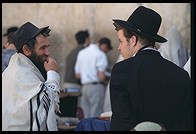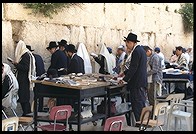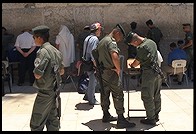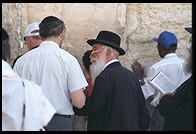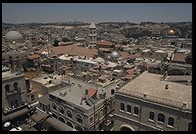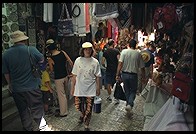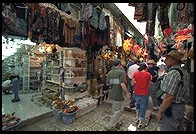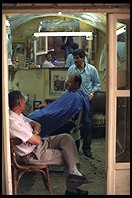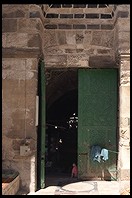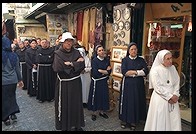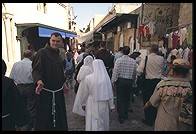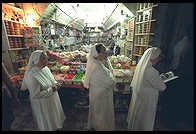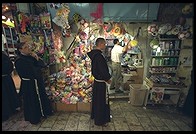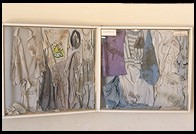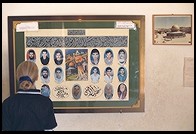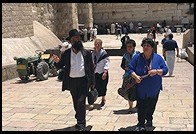 Jerusalem is beautiful, hilly, cool and dry, a
welcome change from the hot humid coast in the summer. The Old City is only about
one square kilometer in size but it can reward days of sightseeing. Within the
Old City the Temple was destroyed by the Babylonians in 586 BC. Within the Old
City Jesus was crucified, buried, and resurrected. Within the Old City the Second
Temple, one of the greatest buildings of the ancient world, was destroyed by the
Romans in AD 70. It was to the Old City that Muhammad dreamed he was transported
in AD 620 and from there rose into heaven (the "Miraj").
Jerusalem is beautiful, hilly, cool and dry, a
welcome change from the hot humid coast in the summer. The Old City is only about
one square kilometer in size but it can reward days of sightseeing. Within the
Old City the Temple was destroyed by the Babylonians in 586 BC. Within the Old
City Jesus was crucified, buried, and resurrected. Within the Old City the Second
Temple, one of the greatest buildings of the ancient world, was destroyed by the
Romans in AD 70. It was to the Old City that Muhammad dreamed he was transported
in AD 620 and from there rose into heaven (the "Miraj").
The photographic highlights of a trip to Jerusalem must include
- people praying at the Western Wall
- the Islamic architecture of the mosques built on the Temple Mount
- the narrow streets of the market in the Christian and Armenian Quarters
- the procession up the Via Dolorosa every Friday at 3:00 pm, led by Franciscan
monks
- roof tops
- the city skyline around sunrise viewed from the Mount of Olives area
- the open market ("souk")
- young people congregating on Ben-Yehuda Street, ideally on Saturday evening,
just after Shabbat
Western Wall
The Western Wall, built by Herod the Great in 20 BC, is pretty much all that
remains of the Second Temple. For Jews, this is the heart of Jerusalem. People
often write little prayers on scraps of paper and stuff them into cracks in the
wall. Orthodox Jews lie in wait for Jewish tourists and encourage them to don
tephillin and pray. Don't be ashamed if you're ignorant. Remember that more than
half of Israelis Jews never go to synagogue. The soldier-tourists that you see at
the Wall speak Hebrew but they might know little about the Jewish religion.
Temple Mount
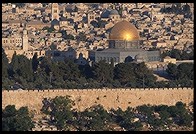 Jerusalem is not
mentioned in the Koran but Islam regards itself as the successor to Judaism and
Christianity. Consequently, for political reasons, the caliph Abd el-Malik
cleared away the rubble on the Temple Mount and built two mosques: Dome of the
Rock (AD 691) and El-Aqsa (AD 705). The Dome of the Rock is probably the finest
building in Israel. No photography is allowed inside the mosques and, as at many
religious sites in Israel, it is disrespectful to wear shorts (if you're not
properly clothed on the Temple Mount, you can rent a robe).
Jerusalem is not
mentioned in the Koran but Islam regards itself as the successor to Judaism and
Christianity. Consequently, for political reasons, the caliph Abd el-Malik
cleared away the rubble on the Temple Mount and built two mosques: Dome of the
Rock (AD 691) and El-Aqsa (AD 705). The Dome of the Rock is probably the finest
building in Israel. No photography is allowed inside the mosques and, as at many
religious sites in Israel, it is disrespectful to wear shorts (if you're not
properly clothed on the Temple Mount, you can rent a robe).
Local folks and tourists approach the Dome of the Rock from different
gates and in different manners...
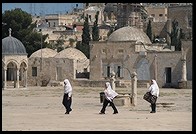
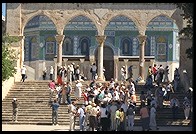
The details in the Dome of the Rock are extremely intricate ...
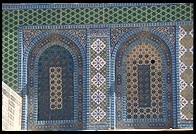
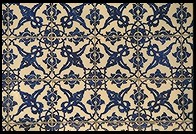
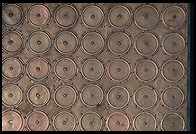
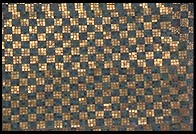
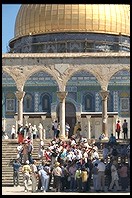
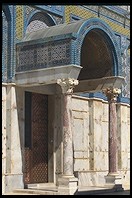
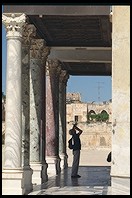
Streets of the Old City
The most interesting and historical streets tend to be in the Christian,
Armenian, and Muslim Quarters.
Via Dolorosa
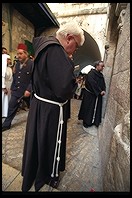 Starting near the Ecce Homo arch in the Muslim quarter, a
procession of pilgrims, led by Franciscan monks, walks along the "14 stations of
the cross" on the Via Dolorosa. This culminates in the Church of the Holy
Sepulchre, built on the spot where Jesus was crucified, buried, and resurrected
(see
http://www.pbs.org/wnet/secrets2/case5.html
for background on archaeological support for the authenticity of the site). It is
an interesting photographic event, not least because of the local Arabs who try
to get on with their shopping.
Starting near the Ecce Homo arch in the Muslim quarter, a
procession of pilgrims, led by Franciscan monks, walks along the "14 stations of
the cross" on the Via Dolorosa. This culminates in the Church of the Holy
Sepulchre, built on the spot where Jesus was crucified, buried, and resurrected
(see
http://www.pbs.org/wnet/secrets2/case5.html
for background on archaeological support for the authenticity of the site). It is
an interesting photographic event, not least because of the local Arabs who try
to get on with their shopping.
According to the guidebook, the procession happens every Friday at 3:00 pm but
I was there in June and it was at 4:00 pm. The discrepancy may be accounted for
by Daylight Savings Time. If you're going to do a good job covering the
procession, I recommend a wide-angle lens (the pictures below were taken with a
Canon 17-35/2.8L zoom). The streets are very narrow and you'll want to get in
close anyway. There will be a lot of contrast and dark areas. A powerful
on-camera strobe used as fill flash would probably be a good idea, though I did
not have one for the images below. Color negative film of at least ISO 400 is
also probably a good idea.
Rewriting History
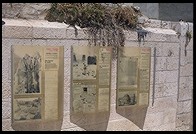 Each of the groups living in Jerusalem tries to rewrite history
to suit current needs. For example, at right is a series of government signs
installed outside the Hurva synagogue in the Jewish Quarter. There were
originally four signs. Three remain. These tell the story of the synagogue's
glorious life from 1864 until the Arabs destroyed it in 1948. The missing panel,
however, would have told the story of the Hurva synagogue before 1864. It was
built by a hassidic community from Poland in the mid-18th century. They didn't
pay their bills so the creditors (presumably Jewish) burned their
synagogue.
Each of the groups living in Jerusalem tries to rewrite history
to suit current needs. For example, at right is a series of government signs
installed outside the Hurva synagogue in the Jewish Quarter. There were
originally four signs. Three remain. These tell the story of the synagogue's
glorious life from 1864 until the Arabs destroyed it in 1948. The missing panel,
however, would have told the story of the Hurva synagogue before 1864. It was
built by a hassidic community from Poland in the mid-18th century. They didn't
pay their bills so the creditors (presumably Jewish) burned their
synagogue.
The Arabs, for their share, maintain on the top of the Temple Mount a little
museum of the blood-stained clothing worn by Palestinian demonstrators who'd been
killed or wounded in clashes with the Israeli Army. Some of these conflicts were
more than 10 years ago and in the intervening time various peace agreements have
been signed. Nonetheless, the outrages of the past are paraded in front of every
new tourist.
Where to Stay
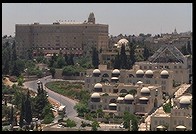 The Old City itself is too tightly
packed to support much in the way of Hotels. Most of the good hotels are in
Modern Jerusalem, a 10 or 15-minute walk from the Jaffa Gate.
The Old City itself is too tightly
packed to support much in the way of Hotels. Most of the good hotels are in
Modern Jerusalem, a 10 or 15-minute walk from the Jaffa Gate.
If you want to relax in between trips, you will definitely want a place with a
pool. The standard luxury hotel in Jerusalem is the King David, built in the
1930s, and equipped with an extremely pleasant garden and pool. The hotel is
famous for having been the headquarters of British administration for the Mandate
of Palestine. It was bombed by Menachem Begin in 1946 as part of a bid to oust
the British and their policies preventing Jews from emigrating to Israel.
Hundreds were wounded in the attack and 80 people were killed. Visit
www.danhotels.com for more info.
Newer, fancier, and at a slightly more convenient location, the
Jerusalem Hilton is very
nice as well. As of summer 2000 neither the Hilton nor the King David had in-room
Internet connectivity so if you want a 10base-T jack in your room, it is probably
best to do some research via phone and email.
philg@mit.edu
 Jerusalem is beautiful, hilly, cool and dry, a
welcome change from the hot humid coast in the summer. The Old City is only about
one square kilometer in size but it can reward days of sightseeing. Within the
Old City the Temple was destroyed by the Babylonians in 586 BC. Within the Old
City Jesus was crucified, buried, and resurrected. Within the Old City the Second
Temple, one of the greatest buildings of the ancient world, was destroyed by the
Romans in AD 70. It was to the Old City that Muhammad dreamed he was transported
in AD 620 and from there rose into heaven (the "Miraj").
Jerusalem is beautiful, hilly, cool and dry, a
welcome change from the hot humid coast in the summer. The Old City is only about
one square kilometer in size but it can reward days of sightseeing. Within the
Old City the Temple was destroyed by the Babylonians in 586 BC. Within the Old
City Jesus was crucified, buried, and resurrected. Within the Old City the Second
Temple, one of the greatest buildings of the ancient world, was destroyed by the
Romans in AD 70. It was to the Old City that Muhammad dreamed he was transported
in AD 620 and from there rose into heaven (the "Miraj").
